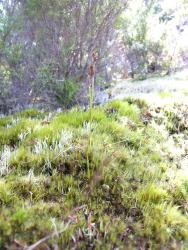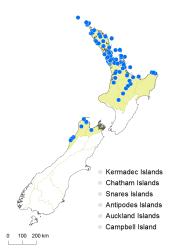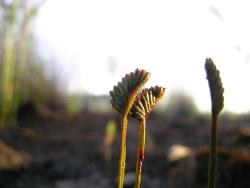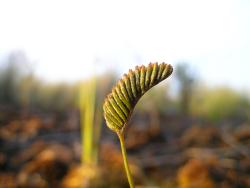- ≡ Acrostichum bifidum (Willd.) Poir., Encyc. Suppl. 1, 126 (1810)
- = Schizaea asperula N.A.Wakef., Victoria Naturalist 59: 89 (1942)
Rhizomes short-creeping; bearing glossy, chestnut-brown, septate hairs, 1.5–5 mm long. Fronds 50–500 mm long, rarely to 650 mm long in sheltered situations, 5–65 mm wide. Sterile portion of frond undivided or dichotomously divided 1–2, or rarely 3 times, erect, 40–500 mm long, or rarely to 630 mm long, ±terete or flattened, furrowed, 0.5–1.0 mm in diameter, green or pale brown, bearing scattered hairs proximally, often scabrid distally. Fertile portions of frond pinnately divided, 5–24 mm long, 3–10 mm wide; fertile branches infolded, in 4–18 pairs, 3–13 mm long, undivided or dichotomously branched 1–2 times, with fimbriate margins. Sporangia borne in one row either side of midrib of fertile branches, 10–30 per branch; long hairs present amongst sporangia.
When well-grown, Schizaea bifida is easily recognised by its dichotomously branching sterile frond portions, which are distinguished from those of S. dichotoma by being terete rather than flattened. Plants with undivided sterile portions of the frond are similar to S. fistulosa but can be distinguished by their scabrid rather than smooth texture, by the longer fertile branches (3–13 mm cf. 2–5 mm long), and by the presence of hairs amongst the sporangia.
North Island: Northland, Auckland, Volcanic Plateau, Gisborne, Taranaki.
South Island: Western Nelson, Sounds-Nelson.
Three Kings Islands.
Altitudinal range: 0–900 m.
Schizaea bifida occurs locally throughout Northland, Auckland and the Waikato/King Country, extending to the East Cape Region and south to the Rotorua/Taupō thermal region, with an outlying population near Ohakune (CHR 35196). It grows from near sea level to about 600 m in the Kauaeranga Forest Park and 900 m on Mt Pirongia. It also occurs up to 120 m in north-west Nelson, from Golden Bay south to Charleston and east to Richmond.
Also New Caledonia and Australia (Queensland, NSW, South Australia, Victoria, Tasmania).
A terrestrial fern found on poor clay and pākihi soils, thermally heated ground, or occasionally in peat swamp. The species is mostly confined to lowland areas, usually under mānuka or kānuka scrub, or occasionally under kauri and low pōhutukawa forest, often in moss carpet. It is hard to find, even where abundant, because of its inconspicuous frond, and is becoming scarcer as its scrub habitats are cleared for farming or forestry.
n = 77 (Lovis 1958).







